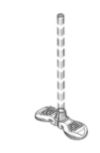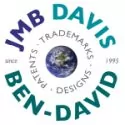Lessons From Larry Junker Versus Medical Components, Martech Medical Products (or How Not to Shoot Yourself in the Foot)
In the United States, designs are examined and maintained as a type of patent, subject to the same patentability requirements as a utility patent. Therefore, to be patentable, a basic requirement is that of novelty. To be novel, a claimed design cannot have been "described in a printed publication, or in public use, on sale, or otherwise available to the public before the effective filing date of the claimed invention" (pre-AIA 35 U.S.C. 102(b)). 1
Regarding, the "on sale" portion of Section 102, the question to be asked is whether "there was a definite sale, or offer to sell, more than 1 year before the effective filing date of the claimed invention and the subject matter of the sale, or offer to sell, fully anticipated the claimed invention or would have rendered the claimed invention obvious by its addition to the prior art." (MPEP 2133.03(b) citing Ferag AG v. Quipp, Inc., 45 F.3d 1562, 1565, 33 USPQ2d 1512, 1514 (Fed. Cir. 1995)). Recently, the US Court of Appeals for the Federal Circuit issued a decision in an ongoing dispute between Larry Junker (Mr. Junker), Medical Components and Martech Medical Products (Larry G. Junker v Medical Components, Inc., Martech Medical Products, Inc., CAFC, February 10, 2022), which addresses the question of whether a quotation letter constituted an offer that falls under the "on sale" portion of Section 102.
Mr. Junker is the owner of US Design Patent no. D450,839 (the D'839 Patent) claiming "[t]he ornamental design for a handle for introducer sheath, as shown and described." (Junker vs. Medical, 4). The design's novel feature is that the handles have "large, rounded Mickey-Mouse shaped ears that made it easier for doctors to grasp the introducer sheath during catheter-insertion procedures". (id.) Figure 1 of the design shows a perspective view of the claimed design:
 (id.)
(id.)
The filing date of the design application was February 7, 2000, which makes February 7, 1999 the critical date for determining the on-sale bar.
In 2013, Mr. Junker sued Medical Components for infringement of the D'839 Patent. As part of the legal proceedings, Medical Components raised a defense of invalidity of the D'839 Patent. The foundation of the invalidity defense was from the business relationship between Mr. Junker and James Edding prior to the filing of the patent application for the D'839 Patent. Mr. Junker sought out Mr. Edding and his company, Galt Medical in order to manufacture his introducer sheaths. In 1998, Mr. Junker and Mr. Eddings entered into a non-disclosure agreement (NDA) before Mr. Junker disclosed his sheath design to Mr. Eddings. Mr. Junker also shared an update to his design with Mr. Eddings. With the assistance of an engineer, Mr. Eddings developed a prototype of the product that included all of the features of Mr. Junker's design. On January 8, 1999, through his newly founded company Xentek Medical, Mr. Edding responded to a request from Boston Scientific Corporation for bulk pricing of "variously sized peelable introducer sheath products". (id. 5).
During trial, the District Court determined that the January 8 letter was not a commercial offer for sale and therefore Medical Components failed to prove its invalidity defense. However, the District Court did find that Mr. Junker was able to prove willful infringement and consequently awarded him over 1.2 million dollars in damages.
On appeal, the Federal Circuit disagreed with the District Court and concluded that the letter was a specific offer for sale. The Court determined that the letter was an offer for sale by relying on the Uniform Commercial Code, Restatement (Second) of Contracts (UCC). The relevant section of the UCC used to determine whether a offer for sale was established states that in "determining whether an offer [has been] made[.] relevant factors include the terms of any previous inquiry, the completeness of the terms of the suggested bargain, and the number of persons to whom a communication is addressed". (id. 10, citing Restatement (Second) of Contracts § 26 cmt. C (1981)).
The Court determined that the letter of January 8, 1999 constituted an offer for sale because the letter was a direct response to a quotation request, made to specific party, delivery conditions and payment terms, all of which elevate the letter to a communication with "complete and definite commercial terminology" for a commercial offer for sale. Although Mr. Junker argued that letter omitted "essential terms", such as the size and quantity of products being purchased, the Court did not find this sufficient to render the letter a mere quotation letter.
So what are the takeaways?
First, if possible, the best way to protect a design or utility invention is to file a patent application prior to entering into a business relationship or prior to offering to sell a product having novel characteristics, regardless of whether those characteristics are "only" ornamental.
Second, it is important to pay attention to the date of publication of an invention or design, as well as to any jurisdiction-specific grace period and to act so as to timely file a patent or design application, as required, so as to properly secure the owner's intellectual property rights.
In Conclusion
There are many pearls of wisdom of the type "look before you leap." The above unfortunate case in which adequate precautions were not taken for a safe landing, should be a lesson for us all. Owners of potential IP should consult with their attorneys about their proposed business actions; and IP attorneys should take an interest in the business activities of their clients, the IP owners.
And all of this is necessary due to the fact that the imperative to look before you leap, or the pain entailed in shooting yourself in the foot, are not likely to change very soon(!)
Footnote
1. The application that led to the subject D'839 Patent was filed prior to the enactment of the Leahy-Smith America Invents Act (AIA), therefore the pre-AIA § 102 applies, however the analysis would still be the same applying the corresponding AIA § 102(a)(1).
Originally published March 2022
The content of this article is intended to provide a general guide to the subject matter. Specialist advice should be sought about your specific circumstances.

